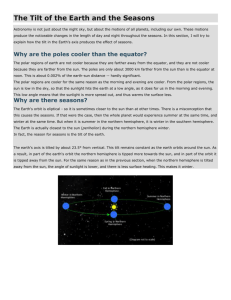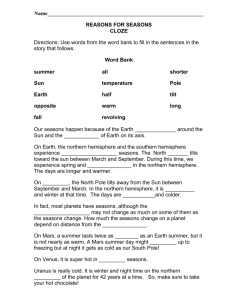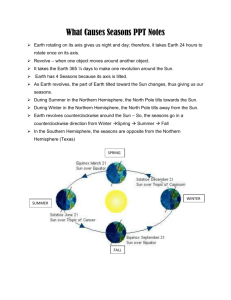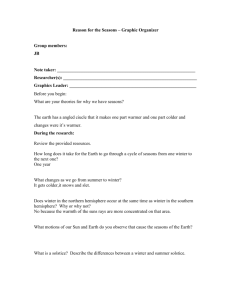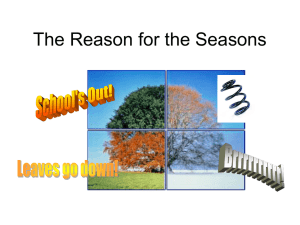Reasoning out the Seasons
advertisement
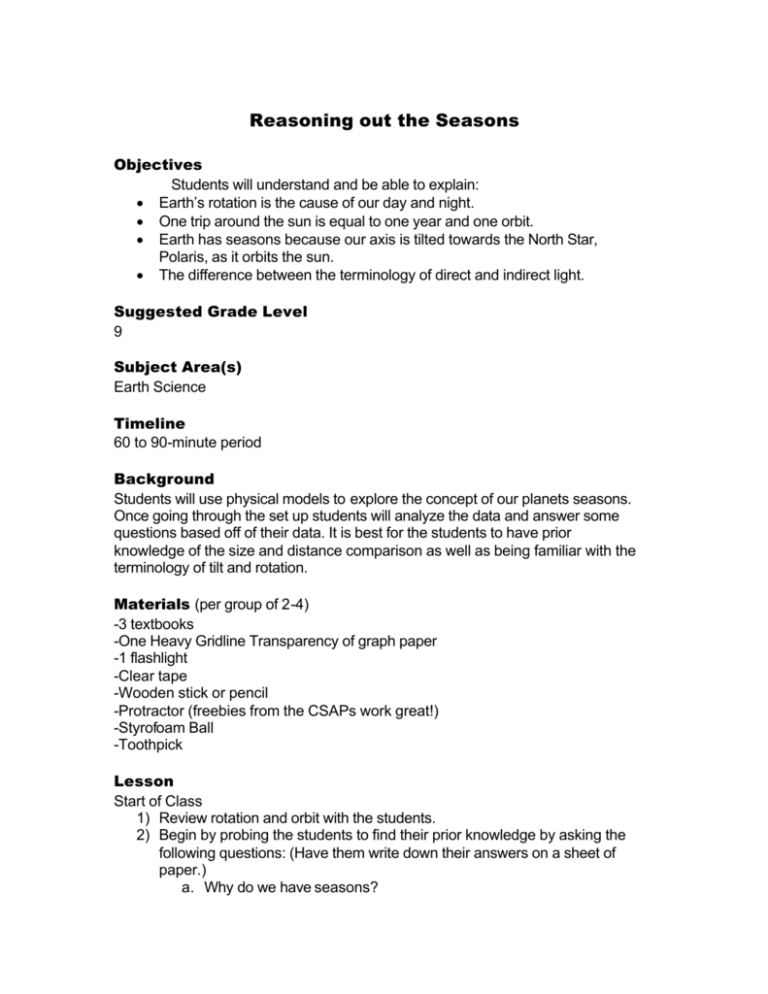
Reasoning out the Seasons Objectives Students will understand and be able to explain: • Earth’s rotation is the cause of our day and night. • One trip around the sun is equal to one year and one orbit. • Earth has seasons because our axis is tilted towards the North Star, Polaris, as it orbits the sun. • The difference between the terminology of direct and indirect light. Suggested Grade Level 9 Subject Area(s) Earth Science Timeline 60 to 90-minute period Background Students will use physical models to explore the concept of our planets seasons. Once going through the set up students will analyze the data and answer some questions based off of their data. It is best for the students to have prior knowledge of the size and distance comparison as well as being familiar with the terminology of tilt and rotation. Materials (per group of 2-4) -3 textbooks -One Heavy Gridline Transparency of graph paper -1 flashlight -Clear tape -Wooden stick or pencil -Protractor (freebies from the CSAPs work great!) -Styrofoam Ball -Toothpick Lesson Start of Class 1) Review rotation and orbit with the students. 2) Begin by probing the students to find their prior knowledge by asking the following questions: (Have them write down their answers on a sheet of paper.) a. Why do we have seasons? b. What is the difference between direct and indirect light? c. How far away from the sun is the planet Earth? Do not give any answers to the questions as you ask them. Make sure that all students have committed to an outcome on their paper. 3) Have the students share their ideas within their small groups to open up their ideas in a safe environment. 4) Next take ideas from the class as a whole. 5) Explain that we are going to test their ideas using some of the materials that we have in class. Begin the Lab Set-up 1) Pass out the student answer and observation sheets. These can be made up or written out on an overhead by the teacher. 2) Have students stack 3 books on top of each other on their table. 3) Next use your clear tape to attach your transparency to your flashlight. 4) Place the flashlight on top of the books. 5) Place your foam ball on your sticks. 6) Using your protractor place ½ of a toothpick at the same tilt as our planet and place ½ at the equator. Make sure that all students are with you at this point. 7) Turn off the classroom lights and have the students turn on their flashlights. 8) Ask, “What do you notice about the shape of the squares located at the equator/ northern hemisphere? Does our planet sit in our orbit like this? What is the angle of our planet’s tilt?” Have the students now tilt the Earth at its correct angle representing summer. 9) Now have students notice what the squares look like at the equator and at the northern hemisphere. 10) Have students log their findings on their data sheets. 11) Repeat steps 7 and 8 for the winter season. 12) Ask, “What do those squares represent? (direct or angled sunlight). Is it warmer or colder in the winter/summer? How does this measure up with amount of sunlight that we receive? While we are in winter what season is the southern hemisphere in? So if different parts of the planet are in different seasons is it possible that the Earth actually moves closer or further away from the sun? (Definitely not!) 13) At this point address and review the background knowledge of the Earth being a pen tip 15 meters away from a sun the size of a grapefruit. 14) Have students review their previous thoughts and now ask if they have had a change in their thinking. Have students write their new thoughts down on their data sheet. 15) Have students answer the questions in the addendum attached and include their previous thoughts and have them turn those in at the end of class for assessment by the teacher. Extensions What would the squares look like in Spring/Fall? Are their other planets in our solar system that experience seasons like Earth does? Evaluation/Assessment • Students will be evaluated on their participation during the lab as well as their responses to the attached questions. Resources NASA Space Foundation Course: Astronomy Principles for the Classroom, July 2004 Addendum 1. When it is winter in the Northern Hemisphere, which areas on Earth get the most concentrated amount of light? 2. Which areas get the most concentrated light when it is summer in the Northern Hemisphere? 3. If the squares projected on the ball from the acetate become larger, what can you conclude about the amount of heat distributed in each square? 4. According to your observations, which areas on Earth are consistently coolest? 5. Which areas are consistently warmest? Why? 6. What time of year will the toothpick’s shadow be longest? 7. When will the shadow be shortest? 8. How are the amounts of heat and light received in a square related to the angle of the sun’s rays? 9. How can you use your observations of an Earth-sun model to explain what causes the seasons?

